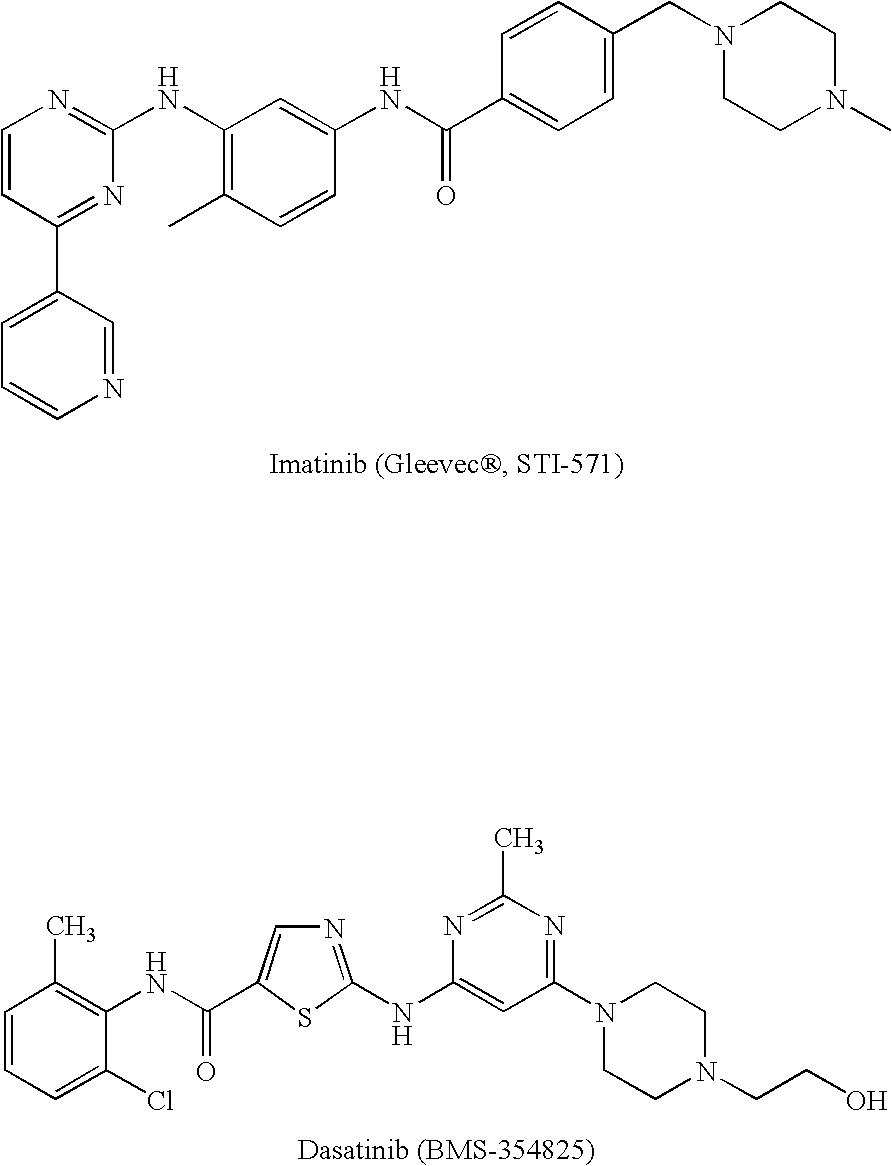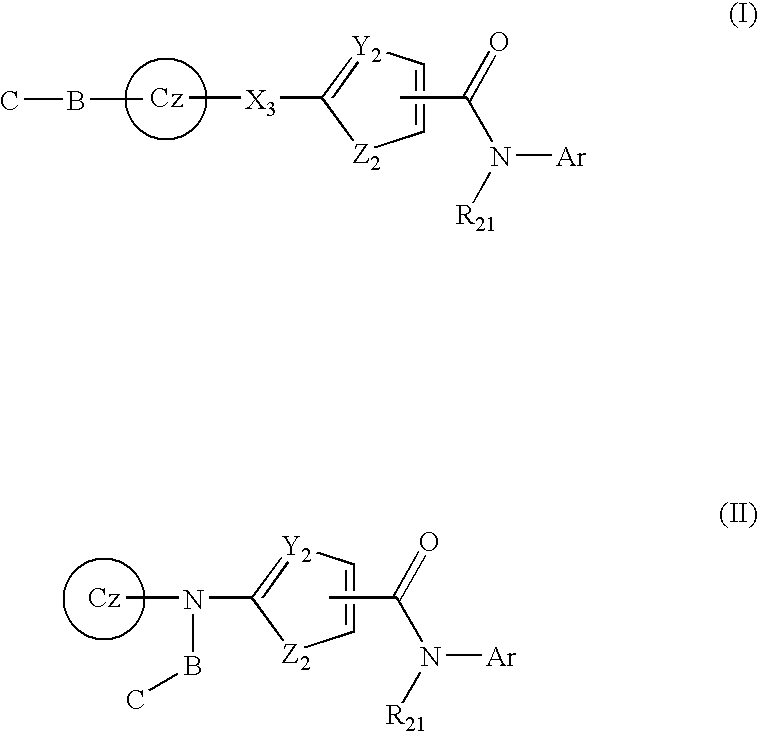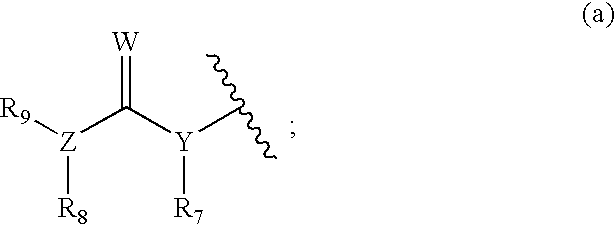Tyrosine kinase inhibitors containing a zinc binding moiety
a zinc binding and kinase inhibitor technology, applied in the direction of biocide, organic chemistry, drug composition, etc., can solve the problems of relapse, drug cocktail use often limited by dose-limiting toxicities, and high effort directed to identifying ways to modulate protein kinase activity, etc., to achieve enhanced activity, inhibit hdac and/or matrix metalloproteinase activity, and improve drug safety
- Summary
- Abstract
- Description
- Claims
- Application Information
AI Technical Summary
Benefits of technology
Problems solved by technology
Method used
Image
Examples
example 1
Preparation of N-(2-chloro-6-methylphenyl)-2-(6-(4-(2-(hydroxyamino)-2-oxoethyl)piperazin-1-yl)-2-methylpyrimidin-4-ylamino)thiazole-5-carboxamide (Compound 1)
Step 1a. 2-chlorothiazol (Compound 102)
[0206]A solution of 2-aminothiazole (101) (20.0 g, 200.0 mmol) in saturated aqueous NaCl (20 mL) and HCl (60 mL) was maintained in a room-temperature bath. It was then treated with NaNO2 (250 mmol) in H2O (50 mL) and concentrated HCl (20 mL) dropwise simultaneously. The reaction was stirred at room temperature for 1 hour, extracted with ether and concentrated at 1 atm. The product was obtained by distilled under vacuum to give 102 as a pale yellow liquid (10.7 g, 45%): 1H NMR (CDCl3) δ 7.24 (d, J=3.6 Hz, 1H), 7.57 (d, J=3.3 Hz, 1H).
Step 1b. 2-Chloro-N-(2-chloro-6-methylphenyl)thiazole-5-carboxamide (Compound 103)
[0207]A solution of 2-chlorothiazol (102) (480 mg, 4.0 mmol) in THF (10 mL) was cooled to −78° C. and treated dropwise with 2.5 M n-butyllithium in hexanes (1.68 mL, 4.2 mmol) ove...
example 2
Preparation of N-(2-chloro-6-methylphenyl)-5-(6-(4-(3-(hydroxyamino)-3-oxopropyl)piperazin-1-yl)-2-methylpyrimidin-4-ylamino)-4H-pyrrole-3-carboxamide (Compound 2)
Step 2a. Methyl 3-(4-(6-(5-(2-chloro-6-methylphenylcarbamoyl)thiazol-2-ylamino)-2-methylpyrimidin-4-yl)piperazin-1-yl)propanoate (Compound 110-2)
[0216]The title compound 110-2 was prepared as a pale yellow solid (0.31 g, 74%) from compound 109 (0.35 g, 0.79 mmol), methyl 3-bromopropanoate (0.13 g, 0.78 mmol), DIEA (0.21 g, 1.58 mmol) and DMF (5 mL) using a procedure similar to that described for compound 110-1 (Example 1): LCMS: 530[M+1]+.
Step 2b. N-(2-Chloro-6-methylphenyl)-2-(6-(4-(3-(hydroxyamino)-3-oxopropyl)piperazin-1-yl)-2-methylpyrimidin-4-ylamino)thiazole-5-carboxamide (Compound 2)
[0217]The title compound 2 was prepared as a white solid (60 mg, 19%) from compound 110-2 (0.31 g, 0.59 mmol) using a procedure similar to that described for compound 1 (Example 1): LCMS: 531 [M+1]+; 1H NMR (DMSO-d6) δ 2.16 (t, J=6.9 Hz,...
example 3
Preparation of N-(2-chloro-6-methylphenyl)-2-(6-(4-(4-(hydroxyamino)-4-oxobutyl)piperazin-1-yl)-2-methylpyrimidin-4-ylamino)thiazole-5-carboxamide (Compound 3)
Step 3a. Ethyl 4-(4-(6-(5-(2-chloro-6-methylphenylcarbamoyl)thiazol-2-ylamino)-2-methylpyrimidin-4-yl)piperazin-1-yl)butanoate (Compound 110-3)
[0218]The title compound 110-3 was prepared as a pale yellow solid (0.22 g, 71%) from compound 109 (0.25 g, 0.56 mmol), ethyl 4-bromobutanoate (0.12 g, 0.56 mmol), DIEA (0.15 g, 0.56 mmol) and DMF (5 mL) using a procedure similar to that described for compound 110-1 (Example 1): LCMS: 558 [M+1]+.
Step 3b. N-(2-chloro-6-methylphenyl)-2-(6-(4-(4-(hydroxyamino)-4-oxobutyl)piperazin-1-yl)-2-methylpyrimidin-4-ylamino)thiazole-5-carboxamide (Compound 3)
[0219]The title compound 3 was prepared as a white solid (30 mg, 14%) from compound 110-3 (0.22 g, 0.40 mmol) using a procedure similar to that described for compound 1 (Example 1): LCMS: 545 [M+1]+; 1H NMR (DMSO-d6) δ 1.69 (m, 2H), 2.01 (t, J=6...
PUM
| Property | Measurement | Unit |
|---|---|---|
| body weight | aaaaa | aaaaa |
| body weight | aaaaa | aaaaa |
| temperature | aaaaa | aaaaa |
Abstract
Description
Claims
Application Information
 Login to View More
Login to View More - R&D
- Intellectual Property
- Life Sciences
- Materials
- Tech Scout
- Unparalleled Data Quality
- Higher Quality Content
- 60% Fewer Hallucinations
Browse by: Latest US Patents, China's latest patents, Technical Efficacy Thesaurus, Application Domain, Technology Topic, Popular Technical Reports.
© 2025 PatSnap. All rights reserved.Legal|Privacy policy|Modern Slavery Act Transparency Statement|Sitemap|About US| Contact US: help@patsnap.com



